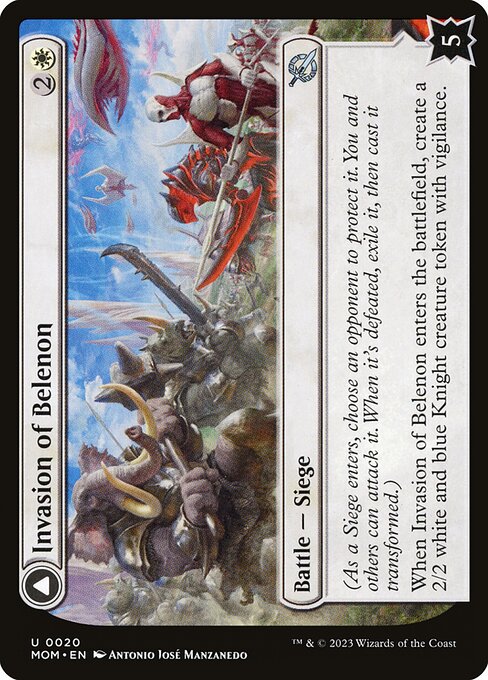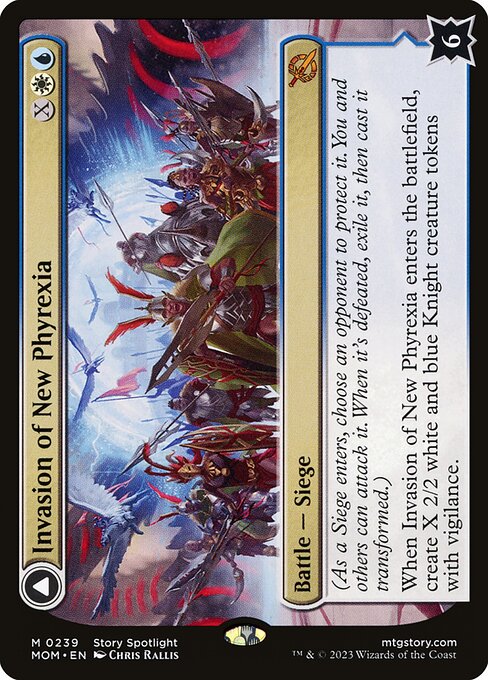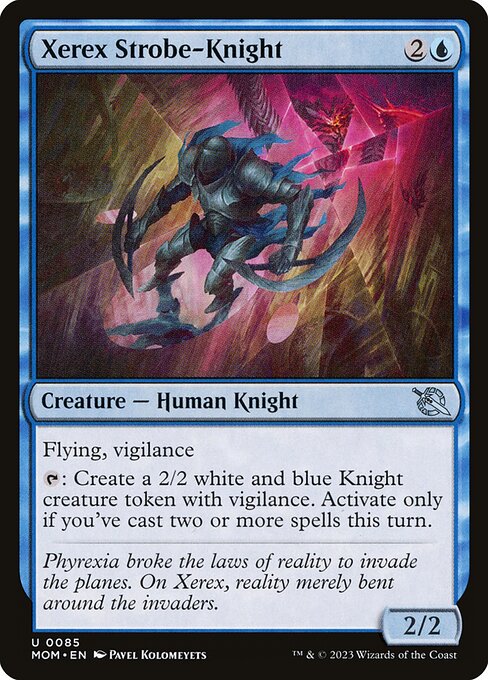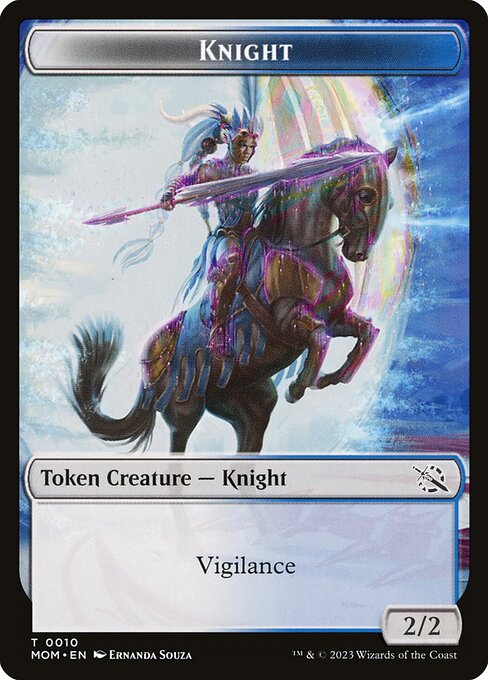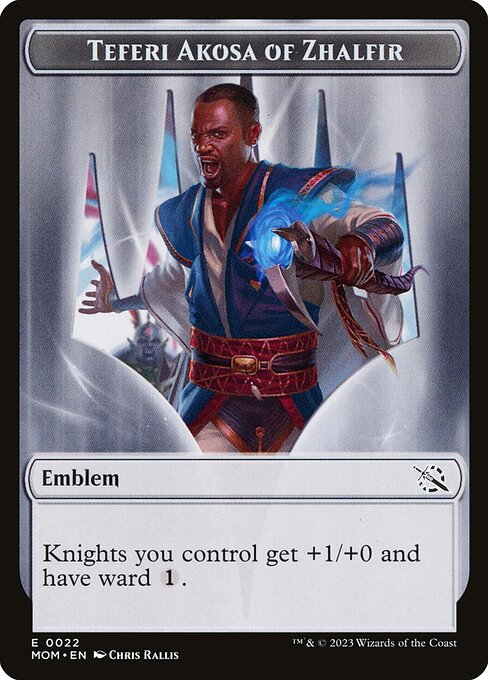新ファイレクシアへの侵攻 // ザルファーのテフェリー・アコサ
//
バトル — 包囲戦 // 伝説のプレインズウォーカー — テフェリー
(包囲戦1つが戦場に出るに際し、それを守る対戦相手1人を選ぶ。あなたや他のプレイヤーはそれを攻撃できる。それが倒されたとき、それを追放する。その後、それを変身させた状態で唱える。)
新ファイレクシアへの侵攻が戦場に出たとき、警戒を持つ白青の2/2の騎士・クリーチャー・トークンX体を生成する。 // +1:カード2枚を引く。その後、あなたがクリーチャー・カード1枚を捨てないかぎり、カード2枚を捨てる。
-2:「あなたがコントロールしているすべての騎士は+1/+0の修整を受け護法を持つ。」を持つ紋章を得る。
-3:あなたがコントロールしているクリーチャーX体をタップする。そうしたとき、対戦相手がコントロールしていてマナ総量がX以下であり土地でないパーマネント1つを対象とする。それをオーナーのライブラリーに加えて切り直す。
新ファイレクシアへの侵攻が戦場に出たとき、警戒を持つ白青の2/2の騎士・クリーチャー・トークンX体を生成する。 // +1:カード2枚を引く。その後、あなたがクリーチャー・カード1枚を捨てないかぎり、カード2枚を捨てる。
-2:「あなたがコントロールしているすべての騎士は+1/+0の修整を受け護法を持つ。」を持つ紋章を得る。
-3:あなたがコントロールしているクリーチャーX体をタップする。そうしたとき、対戦相手がコントロールしていてマナ総量がX以下であり土地でないパーマネント1つを対象とする。それをオーナーのライブラリーに加えて切り直す。
standard
future
historic
gladiator
pioneer
modern
legacy
pauper
vintage
penny
commander
brawl
alchemy
paupercommander
duel
oldschool
premodern
Rulings
A battle’s “defense” is displayed in the bottom right corner of the card. A battle enters the battlefield with that number of defense counters. If another permanent enters the battlefield as a copy of a battle, it also enters with that number of defense counters.
As a Siege enters the battlefield, its controller chooses an opponent to be its protector.
Sieges each have an intrinsic triggered ability. That ability is “When the last defense counter is removed from this permanent, exile it, then you may cast it transformed without paying its mana cost.”
A Siege’s controller can’t be its protector. If a Siege’s protector ever gains control of it, they choose a new player to be its protector. This is a state-based action.
In a multiplayer game, if the protector of a battle leaves the game and that battle is not currently being attacked, its controller chooses a new protector for it as a state-based action. If it is being attacked, its controller chooses a new protector for it once no creatures are attacking it. This means that it continues to be attacked and can be dealt combat damage as normal.
A battle can be attacked by all players other than its protector. Notably, this means a Siege’s controller can attack it.
You activate Teferi Akosa’s last ability without choosing a target or tapping any creatures. As it resolves, you choose which untapped creatures you control to tap, if any. If you don’t tap any creatures (including if you don’t control any), X is 0. After you tap creatures or not, the reflexive triggered ability triggers. You choose the target for that ability as it’s put on the stack.
A battle can be dealt damage and be target of spells and/or abilities that target “any target.”
If a Siege never had defense counters on it (perhaps because a permanent became a copy of one), it can’t have its last defense counter removed. It will be put into its owner’s graveyard. You won’t exile it or cast the other face.
If a token or a card that isn’t represented by a transforming double-faced card becomes a copy of a Siege, it can’t be cast as its triggered ability resolves. It will remain in exile. If it’s a token, it will cease to exist the next time state-based actions are performed.
If a permanent that is represented by a transforming double-faced card becomes a copy of a Siege, it will be exiled as that Siege’s triggered ability resolves, then it will be cast transformed. Note that this applies only to transforming double-faced cards, not to modal double-faced cards that can normally be played using either face.
If a battle has no defense counters, and it isn’t the source of a triggered ability that has triggered but not yet left the stack, that battle is put into its owner’s graveyard. This is a state-based action. This doesn’t cause a Siege’s intrinsic triggered ability to trigger.
Damage dealt to a battle causes that many defense counters to be removed from it.
If a battle that’s being attacked somehow stops being a battle, it is removed from combat. Similarly, if its controller changes in the middle of combat, it is removed from combat.
Battles can’t attack or block, even if one also becomes a creature. If an attacking or blocking creature somehow becomes a battle in addition to being a creature, it is removed from combat.
Teferi Akosa’s last ability has received an update to its official rules text to clarify its function. The updated text is included above.
Only creatures controlled by a battle’s protector can block creatures that are attacking that battle. This means a Siege’s controller can never assign creatures to block for it.
If a non-battle permanent that is already on the battlefield become a copy of a Siege, its controller chooses one of their opponents to be that battle’s protector. However, it will most likely be put into its owner’s graveyard because it has no defense counters (see below).
As a Siege enters the battlefield, its controller chooses an opponent to be its protector.
Sieges each have an intrinsic triggered ability. That ability is “When the last defense counter is removed from this permanent, exile it, then you may cast it transformed without paying its mana cost.”
A Siege’s controller can’t be its protector. If a Siege’s protector ever gains control of it, they choose a new player to be its protector. This is a state-based action.
In a multiplayer game, if the protector of a battle leaves the game and that battle is not currently being attacked, its controller chooses a new protector for it as a state-based action. If it is being attacked, its controller chooses a new protector for it once no creatures are attacking it. This means that it continues to be attacked and can be dealt combat damage as normal.
A battle can be attacked by all players other than its protector. Notably, this means a Siege’s controller can attack it.
You activate Teferi Akosa’s last ability without choosing a target or tapping any creatures. As it resolves, you choose which untapped creatures you control to tap, if any. If you don’t tap any creatures (including if you don’t control any), X is 0. After you tap creatures or not, the reflexive triggered ability triggers. You choose the target for that ability as it’s put on the stack.
A battle can be dealt damage and be target of spells and/or abilities that target “any target.”
If a Siege never had defense counters on it (perhaps because a permanent became a copy of one), it can’t have its last defense counter removed. It will be put into its owner’s graveyard. You won’t exile it or cast the other face.
If a token or a card that isn’t represented by a transforming double-faced card becomes a copy of a Siege, it can’t be cast as its triggered ability resolves. It will remain in exile. If it’s a token, it will cease to exist the next time state-based actions are performed.
If a permanent that is represented by a transforming double-faced card becomes a copy of a Siege, it will be exiled as that Siege’s triggered ability resolves, then it will be cast transformed. Note that this applies only to transforming double-faced cards, not to modal double-faced cards that can normally be played using either face.
If a battle has no defense counters, and it isn’t the source of a triggered ability that has triggered but not yet left the stack, that battle is put into its owner’s graveyard. This is a state-based action. This doesn’t cause a Siege’s intrinsic triggered ability to trigger.
Damage dealt to a battle causes that many defense counters to be removed from it.
If a battle that’s being attacked somehow stops being a battle, it is removed from combat. Similarly, if its controller changes in the middle of combat, it is removed from combat.
Battles can’t attack or block, even if one also becomes a creature. If an attacking or blocking creature somehow becomes a battle in addition to being a creature, it is removed from combat.
Teferi Akosa’s last ability has received an update to its official rules text to clarify its function. The updated text is included above.
Only creatures controlled by a battle’s protector can block creatures that are attacking that battle. This means a Siege’s controller can never assign creatures to block for it.
If a non-battle permanent that is already on the battlefield become a copy of a Siege, its controller chooses one of their opponents to be that battle’s protector. However, it will most likely be put into its owner’s graveyard because it has no defense counters (see below).
Rulings
A battle’s “defense” is displayed in the bottom right corner of the card. A battle enters the battlefield with that number of defense counters. If another permanent enters the battlefield as a copy of a battle, it also enters with that number of defense counters.
As a Siege enters the battlefield, its controller chooses an opponent to be its protector.
Sieges each have an intrinsic triggered ability. That ability is “When the last defense counter is removed from this permanent, exile it, then you may cast it transformed without paying its mana cost.”
A Siege’s controller can’t be its protector. If a Siege’s protector ever gains control of it, they choose a new player to be its protector. This is a state-based action.
In a multiplayer game, if the protector of a battle leaves the game and that battle is not currently being attacked, its controller chooses a new protector for it as a state-based action. If it is being attacked, its controller chooses a new protector for it once no creatures are attacking it. This means that it continues to be attacked and can be dealt combat damage as normal.
A battle can be attacked by all players other than its protector. Notably, this means a Siege’s controller can attack it.
You activate Teferi Akosa’s last ability without choosing a target or tapping any creatures. As it resolves, you choose which untapped creatures you control to tap, if any. If you don’t tap any creatures (including if you don’t control any), X is 0. After you tap creatures or not, the reflexive triggered ability triggers. You choose the target for that ability as it’s put on the stack.
A battle can be dealt damage and be target of spells and/or abilities that target “any target.”
If a Siege never had defense counters on it (perhaps because a permanent became a copy of one), it can’t have its last defense counter removed. It will be put into its owner’s graveyard. You won’t exile it or cast the other face.
If a token or a card that isn’t represented by a transforming double-faced card becomes a copy of a Siege, it can’t be cast as its triggered ability resolves. It will remain in exile. If it’s a token, it will cease to exist the next time state-based actions are performed.
If a permanent that is represented by a transforming double-faced card becomes a copy of a Siege, it will be exiled as that Siege’s triggered ability resolves, then it will be cast transformed. Note that this applies only to transforming double-faced cards, not to modal double-faced cards that can normally be played using either face.
If a battle has no defense counters, and it isn’t the source of a triggered ability that has triggered but not yet left the stack, that battle is put into its owner’s graveyard. This is a state-based action. This doesn’t cause a Siege’s intrinsic triggered ability to trigger.
Damage dealt to a battle causes that many defense counters to be removed from it.
If a battle that’s being attacked somehow stops being a battle, it is removed from combat. Similarly, if its controller changes in the middle of combat, it is removed from combat.
Battles can’t attack or block, even if one also becomes a creature. If an attacking or blocking creature somehow becomes a battle in addition to being a creature, it is removed from combat.
Teferi Akosa’s last ability has received an update to its official rules text to clarify its function. The updated text is included above.
Only creatures controlled by a battle’s protector can block creatures that are attacking that battle. This means a Siege’s controller can never assign creatures to block for it.
If a non-battle permanent that is already on the battlefield become a copy of a Siege, its controller chooses one of their opponents to be that battle’s protector. However, it will most likely be put into its owner’s graveyard because it has no defense counters (see below).
As a Siege enters the battlefield, its controller chooses an opponent to be its protector.
Sieges each have an intrinsic triggered ability. That ability is “When the last defense counter is removed from this permanent, exile it, then you may cast it transformed without paying its mana cost.”
A Siege’s controller can’t be its protector. If a Siege’s protector ever gains control of it, they choose a new player to be its protector. This is a state-based action.
In a multiplayer game, if the protector of a battle leaves the game and that battle is not currently being attacked, its controller chooses a new protector for it as a state-based action. If it is being attacked, its controller chooses a new protector for it once no creatures are attacking it. This means that it continues to be attacked and can be dealt combat damage as normal.
A battle can be attacked by all players other than its protector. Notably, this means a Siege’s controller can attack it.
You activate Teferi Akosa’s last ability without choosing a target or tapping any creatures. As it resolves, you choose which untapped creatures you control to tap, if any. If you don’t tap any creatures (including if you don’t control any), X is 0. After you tap creatures or not, the reflexive triggered ability triggers. You choose the target for that ability as it’s put on the stack.
A battle can be dealt damage and be target of spells and/or abilities that target “any target.”
If a Siege never had defense counters on it (perhaps because a permanent became a copy of one), it can’t have its last defense counter removed. It will be put into its owner’s graveyard. You won’t exile it or cast the other face.
If a token or a card that isn’t represented by a transforming double-faced card becomes a copy of a Siege, it can’t be cast as its triggered ability resolves. It will remain in exile. If it’s a token, it will cease to exist the next time state-based actions are performed.
If a permanent that is represented by a transforming double-faced card becomes a copy of a Siege, it will be exiled as that Siege’s triggered ability resolves, then it will be cast transformed. Note that this applies only to transforming double-faced cards, not to modal double-faced cards that can normally be played using either face.
If a battle has no defense counters, and it isn’t the source of a triggered ability that has triggered but not yet left the stack, that battle is put into its owner’s graveyard. This is a state-based action. This doesn’t cause a Siege’s intrinsic triggered ability to trigger.
Damage dealt to a battle causes that many defense counters to be removed from it.
If a battle that’s being attacked somehow stops being a battle, it is removed from combat. Similarly, if its controller changes in the middle of combat, it is removed from combat.
Battles can’t attack or block, even if one also becomes a creature. If an attacking or blocking creature somehow becomes a battle in addition to being a creature, it is removed from combat.
Teferi Akosa’s last ability has received an update to its official rules text to clarify its function. The updated text is included above.
Only creatures controlled by a battle’s protector can block creatures that are attacking that battle. This means a Siege’s controller can never assign creatures to block for it.
If a non-battle permanent that is already on the battlefield become a copy of a Siege, its controller chooses one of their opponents to be that battle’s protector. However, it will most likely be put into its owner’s graveyard because it has no defense counters (see below).
Your collection? Your decks?
Want to manage your collection and/or create decks?

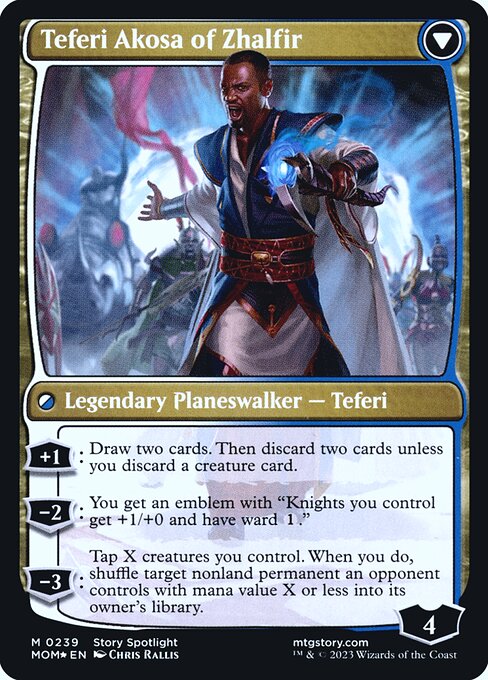
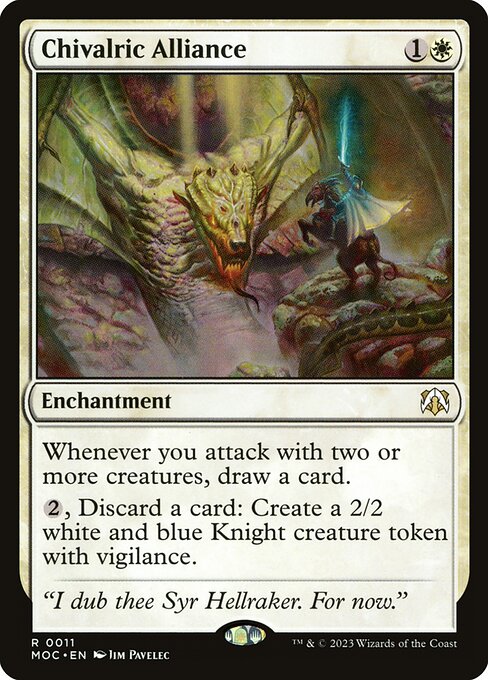

 12.01€
12.01€

